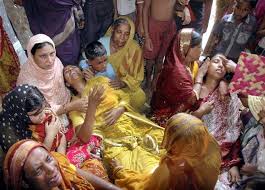
While three persons were killed and seven others injured in Murshidabad district, a 55-year-old voter was killed in CRPF firing when the voters hurled stones at a polling booth at Ratua in Malda district, officials said.
The voters at Ratua were angry as the queue was moving slowly. Four CRPF jawans were also injured in the incident, official sources said.
Panchayat polls were being held on Monday in Murshidabad, Birbhum, Malda and Nadia districts.
In Murshidabad district, a woman voter was killed when bombs were hurled at her by miscreants when she was coming out of a booth at Kajisha village in Beldanga after casting vote, police said.
Two more persons were killed in the district while making bombs at Raninagar village on Monday morning.
A CPI(M) candidate’s husband was shot at in Faridpur gram panchayat area of Jalangi in Murshidabad district. He was admitted to Murshidabad Medical College and Hospital at Berehampore in a serious condition, police said.
A Trinamool Congress supporter received bullet injuries at Islampur area in Murshidabad district.
Four persons were injured when bombs were hurled during a CPI(M)-Congress clash at Juginda area of the district, the police said.
A youth was injured at Ichakali in Jangipur area of Murshadabad district, the police said.
In Birbhum district, father of an Independent candidate was shot at Kasba near Bolpur in Birbhum district.
Hriday Ghosh, the Independent candidate, alleged that the miscreants targetted him but his father was shot at when he came to save him.
Before the polling began, two bodies were found in a paddy field in Birbhum district.
The two villagers were known as CPI(M) supporters but Dilip Ganguly, the district secretary of the party said, “We are not yet sure of their party affiliation”.





Comments
Add new comment